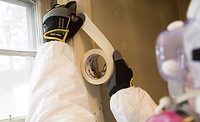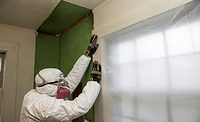Double-Sided Containment Tape Simplifies Restoration, Remediation and Abatement jobs
Cut steps, not corners on mold remediation, asbestos and lead removal, and more

When prepping for restoration, renovation, abatement and remodeling jobs, contractors often use the traditional two-tape, two-step method of applying painter’s tape to protect the surface, then hanging poly-sheeting with duct tape (and sometimes spray adhesive, if necessary). While a tried-and-true method, this approach can become quite costly in terms of labor and material costs.
That’s why Shurtape, a leading producer of pressure-sensitive tapes, is introducing DS 154 double-sided containment tape – a solution that helps contractors cut steps, not corners when creating high-performance containment systems and critical barriers.
DS 154 can be used on a variety of surfaces, including painted drywall and trim, and offers:
- Two tapes in one: The tape’s unique construction centers on a differential adhesive system. The exposed/wall side features a premium grade painter’s tape adhesive (the same used on patented FrogTape® brand painter’s tape) that allows for 21-day clean removal without damage or residue. On the linered side is a specially formulated, aggressive adhesive that securely holds poly-sheeting, tarps and other protective coverings in both wet and dry environments.
- Airtight hold: The double-sided construction results in full surface contact with the poly-sheeting, ensuring a strong, airtight hold that lasts throughout the job, including negative pressure containments.
- One-step removal: When the job is done, the tape and poly-sheeting remove cleanly and easily – in one step.
“Proper preparation for the job is critical to meeting that goal of on-time completion and, in many cases, maintaining the integrity of the original structure,” said Glenn Walter, product manager for building and construction tapes at Shurtape. “But it doesn’t have to be time-consuming and expensive. DS 154 is uniquely engineered to get the job done quickly and easily – eliminating the need for a secondary tape, but still delivering the high performance containment systems and critical barriers demanded by these industries.”
DS 154 is recommended for restoration, renovation, abatement and remodeling tasks such as painting, cleaning, sanding, mold remediation, asbestos and lead removal, and more – particularly those jobs that will not be followed by demolition, where the job, time and costs depend upon the original structure remaining intact.
Looking for a reprint of this article?
From high-res PDFs to custom plaques, order your copy today!






